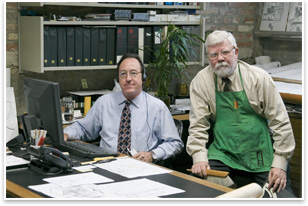
| Grant Simpson, FAIA, and James Atkins, FAIA
Educational background Atkins: Bachelor of science degree in architecture from UT Arlington, same place, in 1974. Hobbies Simpson: I am an avid tropical plant collector. I grow some of them in containers and some I grow in the ground, but I have maybe a hundred pots of tropical plants—citrus trees, breadfruit trees, hibiscus, banana trees, and lots of vines. Another thing that I do—I don’t know if it’s a hobby or community service—but I am a youth basketball coach. I volunteer to coach youth basketball teams. Most of the times those teams include my two sons, who are pretty good basketball players. I’ve done that for 12 years. Mentors Simpson: He did, yes. Atkins: He and I used to do seminars together after I graduated from UT-A. He was a very close friend who taught me a lot. Harwood K. Smith, FAIA, is another, our founder of HKS. And Ronald L. Skaggs, FAIA, our chairman of the board. Those three guys are probably my top mentors, and my dad, who taught me how to work. Simpson: I would say my grandfather, who taught me how to work, and Ronald M. Brame, FAIA, who was the president and the director of commercial architecture at HKS for a long time. He taught me how to consider architecture as a business as well as a design practice. Also Paul M. Terrill, AIA, who taught me the value of client service. Last book read Atkins: Kiss Theory Goodbye by Bob Prosen and—on audio—The World Is Flat by Thomas Friedman. How you became partners in risk management Atkins: I’m the chair of the Risk Management Committee and Grant’s the chair of the Practice Management Advisory Group. [The advisory committees] encourage all of the members to write risk management articles to put in the AIArchitect best practices. Grant and I wrote an article together on risk management that appeared in the May/June 2004 issue of Texas Architect. We really enjoyed doing it and had a great time. It was one of those articles out on the edge that talked about things architects don’t always talk about, and we wound up re-publishing that in AIArchitect in the fall. That prompted us to propose, since the Risk Management Committee wanted us to write articles, a series for AIArchitect, which we did. We actually didn’t get our first article out until February ’05, but we’ve not stopped since then. Next step Simpson: We may start working on that in the middle of the year, so it may be out next year. Practice philosophy Simpson: I think that comment applies for both of us, Jim. Another thing that we both feel strongly about is, for an architecture firm, your client is your greatest asset because without clients, you don’t have an architecture firm. You don’t have an opportunity to practice, so if you build your firm around service to your client and consideration for your client, then your clients will recognize that and keep doing business with you. Advice for young and future architects Atkins: Get up early, move fast, always listen, and ask questions. What’s in store for risk management Simpson: That’s the subject of the entire article series. There are great changes on the horizon in architecture, and BIM promises to be the catalyst for change. Now, whether the profession and allied professions involved in design and construction can ever really implement integrated practice, that’s for the future to decide. |
||
Copyright 2006 The American Institute of Architects. All rights reserved. Home Page |
||
news headlines
practice
business
design
Atkins’ and Simpson’s past articles can be found in the AIA Risk Management Resource Center.

 Summary:
Summary: